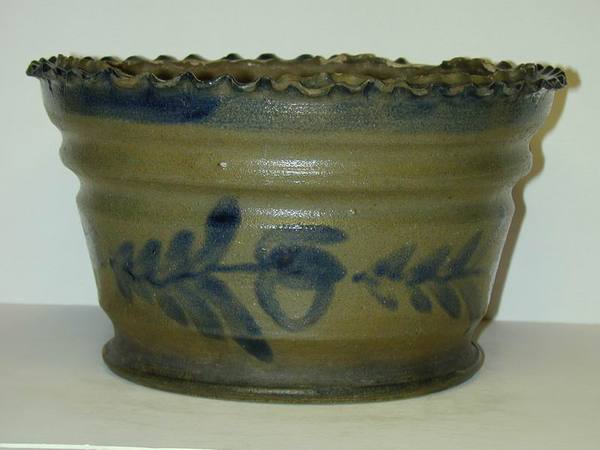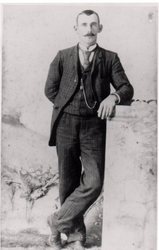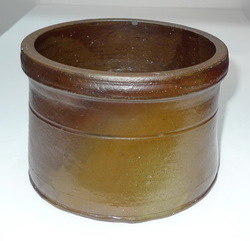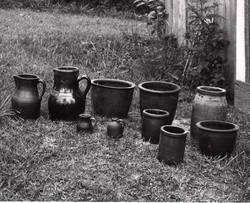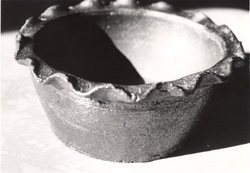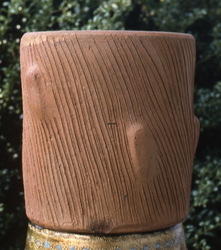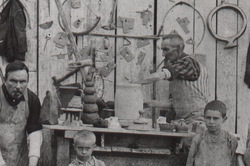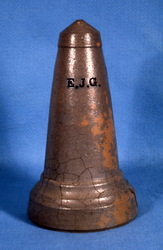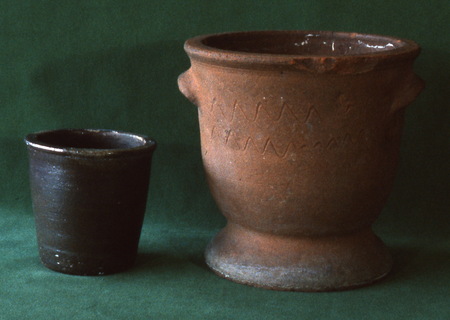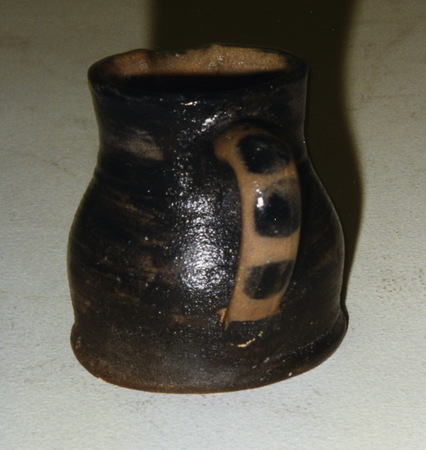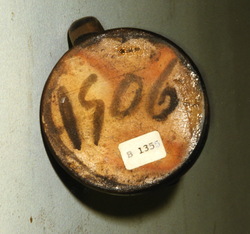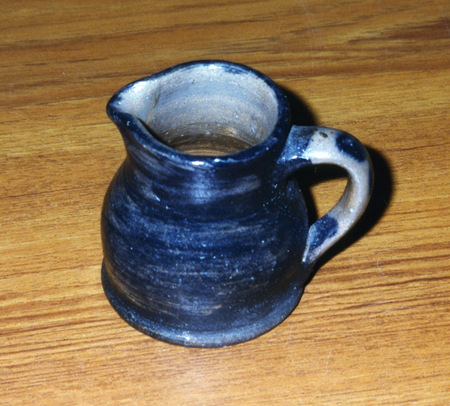Frederick Franklin Decker
“FRED”
June 27, 1862 – February 2, 1936
POTTER FARMER
POTTERY SALESMAN MERCHANT
Unfortunately less is known about Fred Decker than about his older half-brothers, Charles and Billy, or his younger brother, Dick. Only nine or ten years old when the family settled in the Chucky Valley, he grew up on the Decker farm and must have divided his time between the farm and the pottery. Unlike his older half-brothers he has left us no signed pieces of distinctive pottery which would attest to his talent. Indeed the only piece signed by him which is known to have survived is a jug in a form made in great quantity at the pottery. It is owned by one of his descendants now living in Missouri and attempts to obtain it for display with the rest of the Decker collection have been unsuccessful. From examination of a photograph which appeared in a Missouri newspaper a number of years ago the jug does not appear to be decorated in any manner but is signed “F.F. Decker August 20, 1894.” It is possible that other pieces made by Fred will surface in the future and that one will find its way to the Tennessee State Museum so that all of Decker’s sons will have their works on display.
One possible explanation for the scarcity of pieces by Fred Decker is offered by his youngest daughter, Verlin Decker Rambo. She states that her father preferred the selling of pottery from wagons which traveled throughout the trade territory to being confined to the pottery in turning and firing ware. Another may be that he took his young family to Bledsoe County in pursuit of a business opportunity and resided there for several years before returning to the Chucky Valley. A third reason may be that upon his return he borrowed money from his father in order to purchase a twenty-two acre upland farm several miles to the north. Distance and travel time would have made it difficult for him to have spent much time in the pottery while tending the farm where he lived. He also operated a small store beside the road in front of his house which would have left him even less time for travel to the pottery.
While the quest for a noteworthy piece of pottery signed by Fred Decker has been unrewarding, a visit to his former home proved both pleasant and productive. Now owned by Mr. and Mrs. Kenneth L. Taylor, the house has been completely rebuilt and modernized. Mr. Taylor is a grandson of Fred Decker and his mother was Mary, one of the ten children born to Fred and his wife, Sarah Jane Broyles. In clearing and redoing the house the Taylor’s had carefully preserved twelve pieces of the family pottery, five of which were different from pieces found elsewhere. Illustration 1 shows ten of the pieces and the miniature pitcher and jug are of special interest. Pottery records show that these were made at intervals and were sold as “toys” for 5 cents and 10 cents. Surely most of them were broken or discarded for these two are the only ones which have been found to date. The pitcher is 3" high and the tannish gray surface has been largely overpainted in cobalt blue. The date “1906” is incised on the base (Editor’s note: “1906” is brushed in cobalt on the bottom.) and this fact plus the blue over-painting indicates that it was made as a present for some child. Certainly Fred could have made it for one of his children but it is equally likely that “Grandpa” Decker made it as a token for one of Fred’s children. The toy jug is 3-1/2" high and has an almost black manganese glaze. The name “Mary Decker” is written on the base in pencil and the same speculation as to the maker applies to it.
The large pitcher which is second from the left in illustration 1 has an extremely high manganese glaze which shades from dark brown to black. Since there is a firing crack in the base the unusually high glaze may be the result of over firing but whatever the reason it is most attractive. A wavy line was added for decoration around the neck of the pitcher and two lines were deeply incised around the upper body.
Of particular interest among the ten pieces found at the Fred Decker house was a small grayish brown stoneware bowl with a crimped rim shown in illustration 2. Close examination of the now well known photograph of Decker, his sons, and grandsons at work in the pottery (illustration 3siBB) reveals an identical bowl on the wheel at Decker Sr.’s left. It is highly probable that the bowls are one and the same. The same group photograph shows a miniature jug near the bowl and it may well be the “Mary Decker” jug shown in illustration 1. Both pieces may have gone home with Fred Decker from a visit to the pottery. That the bowls are indeed one and the same is further borne out by the fact that the one found at the Fred Decker house is rather small and would have limited utility in use. The top diameter is but 5-3/4" and it is rather shallow. Since it is more decorative than utilitarian it is unlikely that it would have been produced in quantity for sale. We can also add the fact that no other similar one has been found. It is a very attractive little piece and it is fortunate that it was preserved at the Fred Decker home.
The unglazed terra cotta flower pot shown in illustration 4 is important not because it is different but because it is one of many which were made in various sizes over a span of many years. Made to simulate a section cut from the trunk of a tree, it has incised lines to suggest bark and there are five oval projections above the surface which have a smooth finish as though limbs had been cut away. Several entries in the ledgers kept at the pottery show that these pots were priced by the inch with a 4" pot selling for 4 cents, a 5" pot for 5 cents and so on up to a 9" pot at 9 cents. The one illustrated had received a coat of green paint at some earlier date and this may well have been the fate of many of these pots since they were not glazed and had a somewhat unfinished look. Three others were seen and two of them had been given at least one coat of color.
Since this chapter begins with a lament that no signed piece of Decker pottery has been collected with the name of Frederick Decker upon it and the fact is mentioned that he preferred peddling ware from a wagon to turning it in the pottery, it should be pointed out that selling was as important as producing. It was also no easy task to bump over the poor roads of the day and to sell out a wagon load of pottery a piece at a time. When a village or town was reached it was usually possible to find a shed for the wagon and a livery stable for the horses. An inn or boarding house meant a bed for the night and food for himself. But there were other nights on the road when such amenities were not to be had. One of the pottery records lists some of the equipment carried on the wagon; a frying pan, a tin cup, a bucket and a lantern. He surely carried food for himself and the team and a spring or stream beside the road would have provided a stopping place for the night. With the horses watered and fed and a campfire crackling nearby, he had the stars for a ceiling and his accordion for company. The dust and noise of the pottery and the heat of the kiln would have seemed far away.
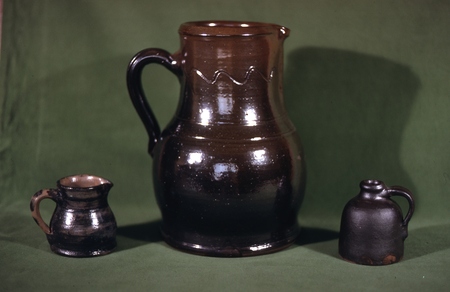
Three pieces of pottery seen in the group of ten on the grass. The small pitcher is basically covered with cobalt and dated on the bottom 1906. Burbage34.
Editor’s note: only a small number of photographs accompanied the essays. An effort will be made to obtain the missing images for this site. For the present, poor quality images were deemed better than no images. An na indicates that no image was available. An si indicates that it is a substituted image. If the source of the substituted image was Beverly Burbage a BB will be affixed. An ai indicates that it is an added image. If the original source of an added image was Beverly Burbage then Burbage will be added to the image caption.
Copyright 2009-2022, Carole Wahler
Site by GearheadForHire, LLC | v1.0.2
